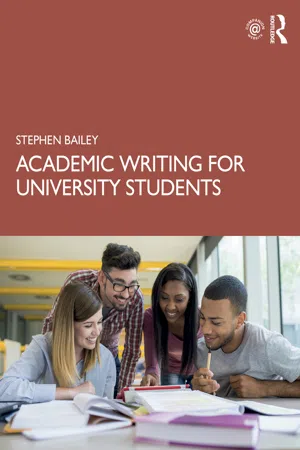
- 308 pages
- English
- ePUB (mobile friendly)
- Available on iOS & Android
Academic Writing for University Students
About This Book
Academic Writing for University Students is designed to help all students succeed in writing essays, reports and other papers for coursework and exams effectively. Academic writing is often the biggest challenge facing college and university students, but this book provides all the tools needed to master the necessary skills.
The book is divided into four parts, to help teachers and students easily find the help they need, both in the classroom and for self-study:
-
- The Writing Process: From finding suitable sources, through to editing and proofreading
-
- Writing Types: Practice with common assignments such as reports and cause-effect essays
-
- Writing Tools: Skills such as making comparisons, definitions, punctuation and style
-
- Lexis: Academic vocabulary, using synonyms, nouns, adjectives, verbs and adverbs
This key handbook breaks down and practises every stage of essay writing. All units are fully cross-referenced, and a complete set of answers to the practice exercises is included. In addition, the companion website hosts comprehensive teaching notes as well as more challenging exercises, revision material and links to other sources.
Designed for self-study as well as classroom use, this book uses authentic academic texts from a range of sources and provides models for common writing tasks such as case studies, while progress checks are included for each part to enable students to assess their learning. Academic Writing for University Students is an invaluable guide to all aspects of academic writing in English.
Frequently asked questions
Information
Part 1 The Writing Process
Unit 1.1 Writing Basics
Most courses assess students through written assignments of various kinds. These tasks include both coursework, which may take weeks to write, and exam answers, which often have to be written in an hour. This unit deals with:
- The purpose of academic writing
- The main features of academic writing
- The names of different writing tasks
- The format of short and long writing tasks
- Sentences and paragraphs
1 The purposes of academic writing
- to report on a piece of research the writer has conducted
- to answer a question the writer has been given or chosen
- to discuss a subject of common interest and give the writer’s view
- to synthesise research done by others on a topic
- Ask a partner if they can suggest any other reasons.
- ____________________________________________________________
- ____________________________________________________________
2 How is academic writing different from other writing genres?
- i) • Working with a partner, name as many writing genres as you can. Then suggest answers to the question above (2).
- ii) • Compare these two extracts from longer texts. What are the main differences between the two genres?
- a) Carrying their few possessions in bags and shopping trolleys, hundreds of desperate storm victims in the Bahamas gathered at a port in Grand Abaco yesterday, hoping to get off the hurricane-blasted island amid rising frustration about the speed of the relief effort. ‘It’s chaos here’, said Gee Rolle, who was waiting with his wife for a boat to the capital, Nassau. ‘It’s not livable for nobody. Only animals can live here’.
- b) Despite the reputation of ‘engineering’ as a politically innocent, technocratic kind of expertise that is above partisan wrangles, the modern engineering profession has from its inception been bound up with power-infused processes of socio-spatial and material transformation. As Andrew Barry (2005: 94) argues, ‘far from having anti-political effects the calculations of engineers [have] had political resonances’.
- rather formal words and phrases are used to explain complex ideas:
(power-infused processes of socio-spatial and material transformation) - citation and quotation to support the writer’s argument:
(As Andrew Barry (2005: 94) argues …) - tendency to use the passive:
(has been bound up with …)
3 Common types of academic writing
- Discuss the differences between them with a partner.

- Match the definitions below to the types above.
- a) The longest piece of writing normally done by a student, often for a higher degree (20,000+ words).
- b) A general term for any extended piece of academic writing.
- c) A description of a situation or process, often with suggestions for dealing with a problem.
- d) The answer to a question or task set by the teacher, often on a theoretical subject.
- e) A detailed account of a particular situation or organisation.
- f) A piece of writing in which students critically examine how they dealt with a situation or task and what they learned from it.
- g) A condensed summary of something read or listened to, for a student’s own use.
- h) A persuasive text written to convince a potential customer to adopt a new product or service.
4 The format of written assignments
- Discuss the meaning of these terms with a partner and then arrange the sections in the most suitable order using the framework below.
- Appendices
- Conclusion
- Discussion
- Literature review
- References
- ...
Table of contents
- Cover
- Endorsements
- Half-Title
- Title
- Copyright
- Contents
- Acknowledgements
- Introduction for Tutors and Lecturers
- Introduction for Students
- Academic Writing Quiz
- Part 1 The Writing Process
- Part 2 Writing Types
- Part 3 Writing Tools
- Part 4 Lexis
- Written British and American English – A Short Guide
- Glossary
- Answers
- Index